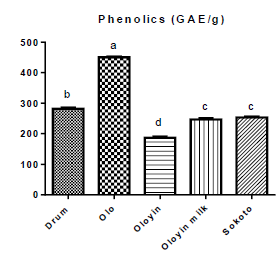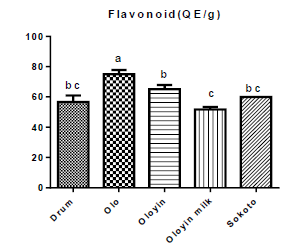Heavy Metal, Proximate and Antioxidant Composition of Five Cultivars of Cowpea (Vigna unguiculata) in Ibadan, Oyo State Nigeria
Article Information
Ailenokhuoria B.V1*, Omolekan T.O2
1Agricultural Value Addition Programme, Institute of Agricultural Research and Training Obafemi Awolowo University, Moor Plantion Ibadan, Nigeria
2Biochemistry Department, Bowen University Iwo, Osun State, Nigeria
*Corresponding Author: Ailenokhuoria B.V, Agricultural Value Addition Programme, Institute of Agricultural Research and Training Obafemi Awolowo University P.M.B 5029 Moor Plantation Ibadan Nigeria
Received: 04 October 2019; Accepted: 21 October 2019; Published: 04 November 2019
Citation: Ailenokhuoria B.V, Omolekan T.O. Heavy Metal, Proximate and Antioxidant Composition of Five Cultivars of Cowpea (Vigna unguiculata) in Ibadan, Oyo State Nigeria. Journal of Food Science and Nutrition Research 2 (2019): 327-332.
View / Download Pdf Share at FacebookAbstract
Five commonly consumed cultivars of cowpea (local names: Olo, Drum, Oloyin, Oloyin milk and Sokoto) were obtained from major market (bodija) Ibadan and were evaluated for heavy metals (Cd, Cr, Ni, Hg, Pb and Ar), proximate (crude protein, fat, crude fibre, moisture and Ash contents) and Phytochemicals (Flavonoid and Phenolic contents). The result shows that, Ar and Ni contents are significantly high amongst the heavy metals for the cultivars examined which is within value range of 0.02-0.13 mg/g d.w. and 0.0017-0.036 mg/g respectively. Oloyin cultivar has the highest Ar contents above tolerance limit above of 0.10 mg/g d.w. The value range of crude protein, fat, crude carbohydrate, crude fibre, moisture and ash contents of the cultivars examined are 26.00-33.00 mg/g d.w., 1.60-2.30 mg/g d.w., 59.0-63.00 mg/g d.w., 2.30-3.20 mg/g d.w., 1.20-4.40 mg/g d.w., 0.80-3.70 mg/g d.w. respectively. The total heavy metal compositions among the cultivars follow this order; Oloyin > Oloyin milk > Sokoto > Drum > Olo. The order for proximate composition is Oloyin milk > Oloyin > Olo > Drum > Sokoto. For flavonoid content, the order is Olo > Oloyin > Sokoto > Drum > Oloyin milk, for phenolics content, the order is Olo > Drum > Oloyin milk > Sokoto > Oloyin.
Keywords
Heavy metals; Proximate; Phytochemicals; Cowpea; Composition; Cultivars; Antioxidants
Heavy metals articles, Proximate articles, Phytochemicals articles, Cowpea articles, Composition articles, Cultivars articles, Antioxidants articles
Article Details
1. Introduction
Cowpea is a one of the major leguminous crop and plant based dietary sources of carbohydrate and protein in the tropic and subtropics where it is widely cultivated, consumed and used for managing protein energy malnutrition. They have trace amount of vitamin A, thiamine, folic acid, niacin, riboflavin, biotin, iron and calcium [1, 2]. Cowpea is majorly cultivated in Northern part of Nigeria. However, cowpea belong to the group of crops that strongly assimilate heavy metals (Ar, Pb, Cd and Hg) which pose serious health hazards to human. Human exposure to heavy metals has risen exponentially as a result of increase in the use of industrial processes, products and chemicals in raw and processed foods as well as use of irrigated water for planting [2]. Moreover, the accumulation of these heavy metals solely depends on the type and parts of plants, Cannabis sativa accumulates cadmium (Cd) most in its seeds [3], while soy beans also accumulates lead (Pb; 0.34 mg kg−1 for FD), Cd (0.23 mg kg−1 for ZX) and chromium (Cr; 1.14 and 1.75 mg kg−1 for FD and ZX, respectively) in its seeds [4]. It has been suggested that activities like funmigation, insecticide and herbicide applications both at pre and post-harvest stages of cowpea production, facilitates the accumulation of heavy metals and hydrocarbons in foods [2, 5]. Therefore, there is need to evaluate the content of toxic nutritional composition in Ibadan Metropolis, Oyo State, Nigeria.
2. Materials and Method
2.1 Area of the studyThe cowpea cultivars were sourced from Bodija market in Ibadan metropolis Oyo State Nigeria between January and February 2019.
2.2 Sampling and data collectionFive clean and insect free cultivars of locally consumed cowpea namely; Olo, Oloyin, Oloyin milk, Drum and Sokoto were randomly collected per bag from three sections of the market into a clean, dry, air tight, and well labelled container. They were thoroughly rinsed in order to remove residues of insecticides applied on them, dried, milled and stored in their respective containers until analysis.
2.3 Heavy metal determinationHeavy metal was determine using Atomic Absorption Spectrophotometer according to the method of A.O.A.C [6]. The result was expressed as mg/g d.w.
2.4 Proximate analysisMoisture, ash, crude fibre, crude protein, crude carbohydrate, crude fats contents of the cowpea cultivars were determined according to methods described by A.O.A.C [6].
2.5 Moisture contentMoisture content determination was carried out using the air oven method at temperature between 103-105°C. Calculation

A known weight of finely ground sample was taken into a clean, dry crucible with a known weight (W1). The crucible was then placed in muffle furnace at 600°C for 6h until it ashed completely. It was then transferred directly to desiccators, cooled and weighed immediately (W2).

The soxhlets extraction method was used for the determination of crude fat with Petroleum ether at 40°C- 60°C boiling range. The fat extracted from a given quantity of sample was then calculated:

The crude protein content was determined using micro Kjeldahl method. It involves digestion, distillation and titration of the sample % Nitrogen content = (Molarity of hydrochloric acid × (Sample titre – Blank titre) × 0.014 × dilution factor)/(Weight of Sample) × 100% N was converted to the percentage crude protein by multiplying by 6.25.
2.9 Crude fibreThe residue obtain from fat extraction was used to determine crude fibre after series of digestion and washing,it was then was cooled and weighed. The loss on ignition was reported as crude Fibre
2.10 CarbohydrateThe carbohydrate content was calculated by difference. % CHO = 100-(Sum of the percentages of moisture, ash, fat, protein and crude fibre)
2.11 Antioxidant compound analysis- Flavonoid: Flavonoid was determined according to the method of Marcano et al. [7]. 1 g of sample was extracted with 10 ml of 80% Methanol. Flavonoid was Express as QE/g (Quercetin Equivalent).
- Phenolics: Phenolics was determine according to the method of Marcano et al. [7]. 2 ml of the extract is mixed with 0.5 ml of Folin-Ciocalteau Reagent and 1.5 ml Sodium Carbonate (20%). Phenolics was express as GAE/g (Gallic Acid Equivalent).
Data were analysed using statistical software (SAS). Means were separated using Duncan Multiple Range Test at P<0.05 level of significance.
3. Result
Values are Mean ± Standard error, n=3, Means with the same letter are not significantly different at P<0.05
Table 1: Heavy metal composition of cowpea cultivars.
Values are Mean ± Standard error, n= 3, Means with the same letter are not significantly different at P<0.05
Table 2: Proximate composition of cowpea cultivars.
4. Discussion
Table 1 shows the presence of arsenic in significant amount in all cultivars evaluated which is in the order Oloyin > Oloyin milk > Sokoto > Drum > Olo while Nickel is present in a negligible amount. Lead, Chromium, Mercury and Cadmium were not detected.
The accumulation among the cultivars may be as a result of the contamination both at pre and post harvest stage of production through use of irrigated water and pest control strategy. The crude protein content is in the order; Oloyin milk > Oloyin > Olo > Drum > Sokoto. Crude carbohydrate is in the order; Oloyin > Drum > Olo > Sokoto. Crude fat is in the order; Sokoto > Oloyin milk > Olo > Drum > Oloyin. Crude fibre is in the order; Sokoto > Olo > Drum > Oloyin milk > Oloyin. Moisture and ash content is in the order; Sokoto>Drum>Olo>Oloyin milk>Oloyin.
Figure 1 and 2 shows the phenolics and flavonoids contents in the cultivars. The phenolics content in the cultivars is in the order; Olo > Drum > Oloyin milk > Sokoto > Oloyin milk while flavonoids content is in the order: Olo > Oloyin > Drum > Sokoto > Oloyin milk. However, despite the highest protein and carbohydrate content in Oloyin and Oloyin milk, the highest arsenic content above tolerance limit as recommended by FAO, 2013 in these cultivars is suggested to make them unsafe for consumption although some cultivars contain arsenic and nickel content in tolerable limit, their accumulation in body overtime could be detrimental. Arsenic is highly poisonous and carcinogenic to human health. The arsenic content of Oloyin and Oloyin nla are 0.10 and 0.12 mg/g respectively. Just like Soybean that accumulates zinc lead and cadmium in their seeds [8], some of the cultivars of cowpea have similar capabilities. It is likely that most of these assimilations occur at storage stage as a result of the insecticides applied on them to prevent infestation of weevils. Many of these insecticides have heavy metals as their active ingredients.
Olo and drum cultivar have a significantly lower content of arsenic which is below the tolerable its level compared to Oloyin and Oloyin milk. This makes it relative safe for consumption. Moreover, all the cultivar showed varying contents of phenolics and flavonoids. Olo and Drum cultivars contain tolerable standard for arsenic. cowpea is one of the major cheap and affordable protein in the developing countries most commonly consumed by both poor and rich in Nigeria, accumulation of these heavy metals overtime could cause harvoc to human health especially arsenic being major potent human carcinogen as cancer is one of the chronic diseases causing over 8.8 million worldwide.
5. Conclusion
The present work show the accumulation of arsenic in cowpea cultivars consume in major market (Bodija) Ibadan which can be detrimental to human health although contain some levels of nutrients and phytochemicals which are regarded as antioxidants, its level and availability after cooking is uncertain. Therefore, regular intake of fruits and vegetables which contain some established level of antioxidants to neutralize the toxic effects of these heavy metals as a result of consumption of contaminated food will be beneficial.
References
- Gonçalves Alexandre, Goufo Piebiep, Barros Ana, et al. Cowpea (Vigna unguiculata L. Walp), a renewed multipurpose crop for a more sustainable agrifood system: nutritional advantages and constraints. Journal of the Science of Food and Agriculture 96 (2016): 2941-2951.
- Chang CY, Xu XH, Liu CP, et al. Heavy metal accumulation in balsam pear and cowpea related to the geochemical factors of variable- charge soils in the Pearl River Delta, South China. Environ Sci Process Impacts 16 (2014): 1790-1798.
- Marcela Mihoc, Georgeta Pop, Ersilia Alexa, et al. Nutritive quality of Romanian hemp varieties (Cannabis sativa.L) with special focus on oil and metal contents of seeds. Chemistry central Journal 6 (2012):
- Ping Zhuang, Zhi-Anli, Bi zou,et al. Heavy Metal Contamination in Soil and Soybean near the Dabaoshan Mine, South China. Pedosphere 23 (2013): 298-304.
- Kearney PC, Helling CS. Agrochemicals :fate in food and the environment :Proceedings of an international symposium on agrochemicals: fate in food and the environment using isotope techniques jointly organized by the international atomic energy agency, IAEA, Austria (1982).
- William H and George WL. Official Methods of Analysis of AOAC International (17th) (2003): 96-104.
- Marcano L and Hasenawa D. Analysis of Phytochemicals In Leaves and Seeds. Agronomy Journal 83 (1991): 445-452.
- Hang Zhou, Min Zeng, Xin Zhou, et al. Assessment of heavy metal contamination and bioaccumulation in soybean plants from mining and smelting areas of southern hunar province, china. Environmental Toxicology and Chemistry 32 (2013): 2719-2727.
- Witthöft C, Hefni M. Encyclopedia of Food and Health. Oxford: Academic Press (2016): 724-730.
- Yaya Liang, Xiaoyun Yi, Zhi Dang, et al. Heavy Metal Contamination and Health Risk Assessment in the Vicinity of a Tailing Pond in Guangdong, China. Int J Environ Res Public Health 14 (2017): 1557


